Multiple Classifiers in Biometrics Part 1 Fundamentals and Review
Abstract
Biometric security is a major emerging concern in the field of data security. In recent years, research initiatives in the field of biometrics have grown at an exponential rate. The multimodal biometric technique with enhanced accurateness and recognition charge per unit for smart cities is still a challenging issue. This paper proposes an enhanced multimodal biometric technique for a smart city that is based on score-level fusion. Specifically, the proposed approach provides a solution to the existing challenges past providing a multimodal fusion technique with an optimized fuzzy genetic algorithm providing enhanced performance. Experiments with different biometric environments reveal pregnant improvements over existing strategies. The result analysis shows that the proposed approach provides ameliorate performance in terms of the false credence rate, false rejection charge per unit, equal fault rate, precision, retrieve, and accuracy. The proposed scheme provides a higher accuracy rate of 99.88% and a lower equal error rate of 0.eighteen%. The vital function of this approach is the inclusion of a fuzzy strategy with soft computing techniques known every bit an optimized fuzzy genetic algorithm.
Introduction
The future of smart urban center security is based on multimodal biometrics. A biometric system is an automated system that recognizes a person related to behavioral or physiological characteristics, and information technology has made considerable progress in a variety of applications, such as surveillance, identification, access control, and protection. Facial characteristics, retinal characteristics, vein patterns, speech patterns, keystroke dynamics, nail bed, ear blueprint, fingerprints, and other biological attributes take also been studied for verification purposes. Amongst these dissimilar traits, fingerprints seem to be a commonly used biometric trait. Additionally, the iris is the nearly accurate biometric considering information technology is distinctive and consequent over time1.
While unimodal hallmark technologies are more than accurate, they only accost a few bug, such as spoofing resistance and good privacy. Personal and biological problems, such as limited sample size and noise tracking devices, have a significant bear on on the accuracy charge per unit of unimodal biometric systems. Multimodal biometrics has been used to verify people to make authentication easier in smart city environments. Multimodal biometric systems have progressively been introduced to solve these issues. Supplementary traits derived from divergent modalities are used in multimodal biometric systems. Multimodal biometric identification systems outperform unimodal biometric security systems in terms of spoofing resistance and improving capabilities2.
The drawback of the existing arroyo is that the efficiency of virtually current multimodal biometric systems is hindered by contradictory classifier ratings. To address this trouble, a new multi-biometric organization based on a machine learning network is presented.
The most appropriate and effective technique for multimodal biometrics for smart cities has been stated, which presents a convergence of information at the scoring stage. The fusion of several biometric modalities focused on matching rankings is gaining popularity and appears to be a very promising arroyo to strengthen accuracy. Some score-level convergence techniques take been adopted thus far for this initiative3. Fuzzy techniques with optimization strategies offer enhanced security and accuracy of authentication systems4. The proposed multi-biometric authentication strategy uses fingerprint and iris biometric traits for recognition5,6. Initially, iris preprocessing is performed with iris localization, iris normalization, and feature extraction. The importance of the application of biometric recognition in smart environments is discussed in7,8,nine.
Similarly, fingerprint preprocessing is performed with various strategies, such as image enhancement, ROI selection, and feature extraction. The fusion is performed at score level matching using an enhanced optimized fuzzy genetic algorithm (OFGA). This feature enables the simulation of the furnishings of specialized soft computing techniques such as a genetic collection of rules, adaptive fuzzy models, and other similar techniques used to combine similarity scores in a multimodal biometric system. Consequently, information technology has been demonstrated that combining rankings optimization algorithms and fuzzy systems outperforms other well-known strategies in multimodal biometric method verification or recognition10, irrespective of the nature of the biometric modality.
The major contribution of the proposed research is specified as follows:
-
To develop an optimized fuzzy genetic algorithm for enhanced multimodal biometric fusion and develop an efficient multimodal biometric recognition organization for smart cities
-
To achieve amend ranking optimization compared to other soft computing approaches
-
To evidence the efficiency of the proposed methodology, the proposed approach is compared against existing state-of-the-art approaches.
The remainder of the paper is organized equally follows. Related works are provided in the second department. "Proposed methodology" section describes the proposed methodology that uses an optimized fuzzy genetic algorithm for score-level fusion to raise recognition. "Results and discussion" section describes the outcome analysis with two standard datasets of fingerprints and irises. "Conclusion" department concludes the proposed enquiry by highlighting the performance comeback.
Related works
Experts in the field of multimodal biometric security have developed several methods. A brief overview of some significant contributions to the current literature is discussed in this section. Gavisidappa et al. eleven. devised an efficient feature selection technique to decide the all-time-selected features for optimizing multimodal biometric identification efficiency. Following extracting features, the revised relief feature selection technique was used to deny irrelevant attributes and pick the best attributes. In an attempt to discover the closest miss and closest hit cases, a modified algorithm was used that used Chebyshev distance rather than just Manhattan altitude.
Jagadiswary et al. 12. suggested a multimodal authentication system that uses feature extraction from various modalities, such as fingerprints, retinas, and finger veins. The RSA algorithm is used for fundamental generation and encryption. The experimental assay revealed that they have enhanced functioning in terms of GAR of approximately 95.3% and FAR of approximately 0.01%. Vidya & Chandra13 nowadays a novel security model for cloud-based encrypted storage that uses times of high-demand authentication by combining unlike biometric modalities from individuals and granting or denying access based on the results. ELBP is a modern texture-based dimensionality reduction technique that is proposed to stand for entropy details in i dimension using a local binary pattern feature vector. There is no need for quantization with the ELBP part extraction method. Yang et al.14 examined the outcome of feature composition on multi-biometric device matching results using a multi-biometric framework based on fingerprints and faces that uses characteristic-level fusionfifteen. They apply a per centum weight and a random project-dependent transformation. It has also been demonstrated that allocating disproportionate amounts to features from various biometric features results in dissimilar matching outputs by irresolute this loss role.
Fuzzy logic has several common characteristics, such as allocated information representation and epitome approximation, also every bit the capacity to interact with documents with ambiguity and inconsistency. Fuzzy logic tolerates data inaccuracy in the aforementioned way that neural networks tolerate noisy records. The mastering capability of a neural network is a fantastic fashion to alter an expert's theory, and it automatically creates more fuzzy instructions and club capabilities to meet real-earth requirements. This cuts down on both layout time and cost. The fuzzy logic framework, on the other hand, is probable to heighten the generalization features of a neural network past providing greater reliability16. When developing a multimodal biometric device, the fusion methodology adopted has a pregnant consequence on its efficiency. Characteristic-level fusion is the well-nigh stable of the dissimilar fusion techniques. The characteristic set derived from multiple biometric features and used for multimodal device pattern could be inconsistent17.
Several methods using fuzzy basic logic to improve biometric fusion have been suggested in recent literature. In addition, fuzzy-based preference fusion is used on three biometrics where voting strategies are used. The fuzzy logic for fusion and the probability ratio-based complete fusion scheme were explored18,19.
For security purposes, Sujithra et al. xx. used multimodal biometrics such as heartbeat-based ECG signals every bit individual components in fingerprint systems. This has been used equally a controlled instrument to capture the heartbeat pulse from twenty-ii subjects' fingertips, as well as to assess the unimodal method of using the heartbeat alone. During the fusion stage of multimodal identification technologies, Selwal et al.21 developed a wedlock operation of fuzzy correlations of modality templates. This method accomplishes both feature fusion and the translation of several templates into a unique, reliable, noninvertible template. The proposed methodology is irreversible, versatile, and has been tested on a bimodal biometric organisation that includes fingerprints and iris scans.
Tong et al.22 depict some intelligent algorithms with specific implementations to make cities smarter. The new urban framework for smart environments provides many opportunities to come across new challenges while solving concrete problems at the aforementioned time. Also, Huang et al.23 put the focus on multi-modal data perception using some car learning algorithms. The experiment results evidence that the proposed methods and recognition approaches are constructive and feasible. Pang et al.24 suggest a novel method based on the collaborative image that allows multiple city digital twins (DT) using federated learning (FL). This approach allows sharing the local strategy and provides a global model in multiple iterations at different city DT systems. An interesting written report based on an intelligent monitoring organization is presented by Mabrouki et al.25. Experimental results carried out at various locations prove some new interesting findings in the IoT-based motility intelligence monitoring arrangement.
Proposed methodology
Matching scores provide plenty details to differentiate legitimate and impostor cases, and they are hands obtainable, so score-level fusion is widely used in multimodal biometric systems. Even without knowing the fundamental feature extraction and matching algorithms of each device, matching scores for a prespecified number of users tin can exist produced provided several biometric systems.
The proposed methodology employs the score-level fusion technique based on an optimized fuzzy genetic algorithm. Initially, the finger and iris biometrics of the user are obtained and preprocessed. The characteristic extracted from the preprocessing pace is matched against the biometrics stored in a database. The fusion of scores is done by using an optimized fuzzy genetic algorithm. The flow of the proposed approach is shown in Fig. i.

The flow of proposed approach for smart city.
Iris preprocessing
The iris, which is role of ocular biometrics, is an externally noticeable yet secure organ with a special epigenetic pattern that remains stable during machismo. Every bit a result of this belongings, it is a critical methodology for use as a biometric for identification. If a person wants to be recognized by an iris recognition system in smart environments, their eyes are examined first, and so a image is produced. This template is and then matched to other templates in a database before a match is found, or it remains unknown. The steps involved in iris preprocessing are iris localization, iris normalization, and feature extraction.
The proposed scheme uses the "Wildes iris localization" strategy. The characteristics of this approach are the combination of the Hough transform and border map to localize iris and pupil boundaries. Initially, information technology will extract the edge map from the iris image and use the image intensity gradient as follows (1):
$$\left| {\Delta g(due south,t)*i(x,y)} \right|$$
(1)
where \(\Delta g(s,t)\) denotes the 2D Gaussian filter centered at s,t and \(i(10,y)\) denotes the iris image with the locations x and y.
The subject field was biased vertically for limbic boundary localization and horizontally for eyelid localization, suggesting that the subject's head was in a standing posture. Once the edge map is extracted, boundaries are extracted from student and limbic boundaries. For the iris prototype to be localized, with center (ten, y) and radius r, the Hough transform function is defined equally (2):
$$H(x,y,r) = \sum\limits_{i = one}^{n} {(p,q,x,y,r)}$$
(two)
where (p,q) are pixel locations.
The normalization technique used in the proposed approach is Daugman's rubber sheet model. The pixels from Cartesian to polar coordinates are designed every bit follows:
$$I(u(r,\theta ),v(r,\theta )) = I(r,\theta )$$
(iii)
$$u(r,\theta ) = (i - r)x_{p} (\theta )$$
(iv)
$$5(r,\theta ) = (one - r)y_{p} (\theta )$$
(5)
The iris characteristic extraction used in this proposed approach is the log Gabor filter technique1. The conventional option of filters in feature extraction is normal Gabor filters. Typically, they suffer from ii major drawbacks: their maximum bandwidth is limited to approximately one octave, and they are not ideal for obtaining broad spectrum content with maximal spatial localization. Thus, a logarithmic Gabor filter called the log-Gabor filter is introduced every bit an alternative to the normal Gabor filter. This log-Gabor filter is based on the fact that when viewed on a logarithmic frequency calibration, the natural images can exist better coded using filters having a Gaussian transfer function. When analyzed on a linear scale ranging, Gabor functions have a Gaussian kernel part. A log-Gabor filter'south frequency response can exist written as (half-dozen):
$$One thousand(s) = \exp \left\{ { - 0.5 \times \frac{{\log \left( {\frac{s}{{s_{0} }}} \right)^{ii} }}{{\log \left( {\frac{\sigma }{{s_{0} }}} \right)^{ii} }}} \right\}$$
(6)
Fingerprint preprocessing
Fingerprint preprocessing consists of 3 steps: epitome enhancement, region of interest (ROI) selection, and characteristic extraction.
A graphics file is used to read an image as input. To transform the paradigm into a norm or assume a constant scale, bilinear interpolation is used. The region of interest is identified past the normalization technique. Initially, the input image is divided into various blocks \(n \times north\), and the standard divergence tin can exist obtained as \(std(i)\). If the obtained standard divergence value is greater than the stock-still threshold, the image tin can be marked as part of the fingerprint. The normalized image is given equally
$$i(x,y) = i(ten,y) - mean(i)$$
(7)
$$i(x,y) = i(10,y)/std(i)$$
(eight)
$$i_{g} (x,y) = rm + i(ten,y) \times sqrt(rv)$$
(9)
where rm denotes the required mean, rv denotes the required variance, and \(sqrt\) denotes the square root function.
Gabor filter techniques are applied in addition to the in a higher place criteria to enhance the image. Normalization, division of the ridge area, morphological elimination of small artifacts and approximation of the local orientation of ridges in a fingerprint are all role of the optimization phase. Thinning is practical to the binary image that has been collected.
ROI selection involves the identification of core points from the enhanced image. To obtain the region of interest, n pixels around the core point will be selected. Amend to choose the value of n is 100 to 200 points so that adequate is around the cadre will be considered as ROI.
For perfect characteristic extraction from fingerprints, a line-based extraction algorithmone is used. All associated line segments concerning all pixels are calculated using adaptive threshold analysis and the ridge tracing method. The extraction of minutiae is achieved past block extraction.
Score-level fusion based on the optimized fuzzy genetic algorithm (OFGA)
The proposed technique uses OFGA to enhance the recognition of fingerprints and iris biometrics in the multimodal biometric recognition approach for smart cities. The higher morphological features of finger and iris biometrics are used for biometric evaluation. The matching rate used in this approach is defined equally follows (x and xi):
$$MR_{f} = w_{f} m_{f}$$
(10)
$$MR_{i} = w_{i} m_{i}$$
(xi)
where \(MR_{f}\) and \(MR_{i}\) announce the matching rates of the fingerprint and iris, \(w_{f}\) and \(w_{i}\) denote the weights of the fingerprint and iris, where \(m_{f}\) and \(m_{i}\) announce the matching scores of the fingerprint and iris, respectively.
Among the various fusion regulations, the weighted sum rule is perceived as a variety of excellent ways of fusing the matching rates from diverse modalities to accomplish better performance. The fusion rule is denoted here every bit a linear combination of the variable given in Eq. (12):
$$M_{Due south} = w_{i} m_{i} + w_{f} m_{f}$$
(12)
Optimized weight selection is necessary to implement meliorate biometric fusion. Hence, the OFGA is proposed to achieve enhanced recognition. The OFGA method is a stochastic optimization method that is entirely based on a couple of parallels that seeks adequacy combined with genetic operations at some signal during population evolution. The OFGA method is the combination of the fuzzy approach and a genetic algorithm where mutation and crossover are incorporated to minimize convergence. The goal of this proposed OFGA is a minimization of weights given in Eq. (13):
$$obj(Z) = \mathop {Min}\limits_{w} (w_{i} ,w_{f} )$$
(13)
where \(obj(Z)\) is the objective part of characteristic Z with minimization of weight vector w.
The best mode to attain the overall performance is minimizing the equal error charge per unit (EER). The steps involved in the genetic algorithm are:
- (a)
Initialization
- (b)
Fettle function
- (c)
Choice
- (d)
Crossover and mutation.
Initialization
The genetic algorithm performs randomization of the initial population as the very first pace in the suggested optimization algorithm. Each role in the random sampling population is entirely vector-based and reflects all methods. The duration of the population is kept constant in this method.
Fitness role
In this proposed approach, EER and accuracy are considered to be the fitness office. A higher value of accuracy and a lower EER announce enhanced biometric recognition. Each member of the population is assigned a fitness value that is more closely related to the fitness function. As a result, the fitness value reflects the importance of each function and contributes to the convergence of the global value at the end of the mission.
Fuzzy clustering arroyo
Fuzzy clustering is a type of clustering where each data point tin be allocated to multiple clusters. The population pick is denoted past an OFGA algorithm, where for every population \(y = \left( {y_{1} ,y_{2} ,y_{iii} ,,y_{n} } \right)\), it defines the rules to split the information into various clusters \(C = \left( {c_{one} ,c_{2} ,c_{3} ,,c_{m} } \right)\) to minimize the data feature \(O_{ten}\) where the fuzziness is limited by the factor \(x\). The partition matrix is denoted past \(Westward = w_{ij}\), which indicates that element \(y_{i}\) belongs to \(C_{j}\) (14):
$$\mathop {\arg \_\min }\limits_{C} = \sum\limits_{i = i}^{i = n} {\sum\limits_{j = 1}^{j = m} {w_{ij} \left| {y_{i} - c_{j} } \correct|} }^{two}$$
(14)
where
$$w_{ij} = \frac{1}{{\sum\limits_{k = 1}^{m} {\left( {\frac{{y_{i} - c_{j} }}{{y_{i} - c_{m} }}} \right)^{{\frac{2}{grand - ane}}} } }}$$
(fifteen)
For the next decade, the entities cluster with the highest fitness values is considered. The cluster with the everyman boilerplate has to be the worst, and it is excluded during the side by side generation. The features of this magnificence are advantageous for fast searches and extending the discovery process within the search room. This bureau could serve as a transition zone for some exploitation and exploration. Although significant changes are made to them to search for improve alternatives, the function with a low objective function is not removed.
Crossover and mutation are very important parameters in chromosome diversification. So,\(p_{c}\) and \(p_{m}\) denote the probability of crossover and mutation, respectively. To acquire the strengthened solution, the importance of \(p_{c}\) and \(p_{grand}\) in phase could dramatically change the convergence growth rate. The crossover and mutation operators' corresponding correlations and probabilities are applied to the global solution. The solution is specified in Eq. (xvi):
$$p_{i}^{j} = y_{i}^{j - 1} \times rand\left( {y_{i}^{j - 1} - x_{i}^{j - i} } \right)$$
(xvi)
where \(p_{i}^{j}\) represents the probability of crossover with i = c and the probability of mutation with i =m; \(\left( {x_{i}^{j} ,y_{i}^{j} } \right)\) denotes the degree to which random selections of \(p_{c}\) and \(p_{m}\) are made. The intervals of crossover and mutation are \([0,1][0,1]\) and \([0,0.1]\), respectively.
Results and give-and-take
When compared to unimodal biometric authentication, multimodal biometric hallmark proved to have enhanced security and privacy. Fingerprint and iris recognition are used in the multimodal biometric organisation for smart city environments.
Experimental setup
The proposed work is simulated using a Python programming language with 6 GB RAM and ani5 processor. The data used in the proposed approach are the CASIA iris V3 dataset and the FVC2006 fingerprint dataset. CASIA-IrisV3 is divided into 3 subgroups: CASIA-Iris-Interval, CASIA-Iris-Lamp, and CASIA-Iris-Twins. CASIA-IrisV3 comprises 22,034 image features from over 700 different subjects. Iris images were captured using infrared light illumination and are eight bit greyness-level JPEG files. The FVC2006 competition aims at evaluating fingerprint hallmark tools. Authorized participants were given a subset of fingerprint observations collected with dissimilar sensors to fine-tune the specifications of their algorithms. The benchmark will consist of iv distinct databases given by the organizers: DB1, DB2, DB3, and DB4. That database spans 150 fingers and includes 12 specimens per finger. The notations used in the proposed arroyo are false positives (FPs), true negatives (TNs), faux negatives (FNs), and truthful positives (TPs)26.
Performance evaluation on CASIA V3 and FVC2006 datasets
The effectiveness of the proposed arroyo is based on the following different metrics.
-
Simulated Acceptance Rate (FAR): This refers to the likelihood of a system incorrectly accepting a nonregistered or unauthorized user.
$$FAR = \frac{FP}{{TN + FP}}$$
(17)
-
False Rejection Charge per unit (FRR): This refers to the likelihood of a system incorrectly rejecting a nonregistered or unauthorized user.
$$FRR = \frac{FN}{{TP + FN}}$$
(18)
-
True positive rate (TRR): This indicates the likelihood of a device authorizing the registered user. Information technology is also known as sensitivity.
$$TPR = \frac{TP}{{TP + FN}}$$
(19)
-
True Negative Rate (TNR): This determines the likelihood of the authorized user existence approved by a organization. It is otherwise defined as recall or specificity.
$$TNR = \frac{TN}{{TN + FP}}$$
(20)
-
Accuracy: Registered users permitted at a rate proportional to the number of attempts they fabricated.
$$Accuracy = \frac{{\left( {TP + TN} \right)}}{{\left( {TP + TN + FP + FN} \right)}}$$
(21)
-
Equal error rate (EER): The rate at which FAR is equal to FRR is known every bit EER.
-
Precision: This indicates the ratio of positive instances plant amidst all positives mentioned. It is otherwise denoted as a positive predictive value.
The efficiency of the proposed arroyo is analyzed for the iris and fingerprint at various samples. Table 1 and Table 2 specify the analysis on various parameters with different data densities without OFGA and with OFGA (N is number of iris and fingerprint samples).
Similarly, the biometric organisation with lower equal fault rate provides better performance. The EER is almost important metric in biometric recognition system for measuring enhanced functioning. The EER of the proposed Iris and fingerprint recognition without OFGA is 0.33%. Similarly, the EER of the proposed Iris and Fingerprint recognition with OFGA is 0.18%.
The accuracy of the proposed arroyo is 99.73% without an optimization algorithm and when the optimization procedure included the accurateness is enhanced to 99.88%. The average functioning analysis of the proposed approach in terms of FAR, FRR, TPR, TNR, accurateness, EER, and precision is specified in Table 3.
The FAR and FRR of the CASIA V3 iris dataset are shown in Fig. two. The curve shows that the average FAR and FRR rate of the iris dataset are 0.13% and 0.20%, respectively. The TPR and TNR is an of import metric for a biometric recognition system. The TPR and TNR of the proposed arroyo without OFGA is 99.79% and 99.88% respectively. Similarly, the TPR and TNR of the proposed arroyo with OFGA are 99.79% and 99.88% respectively.
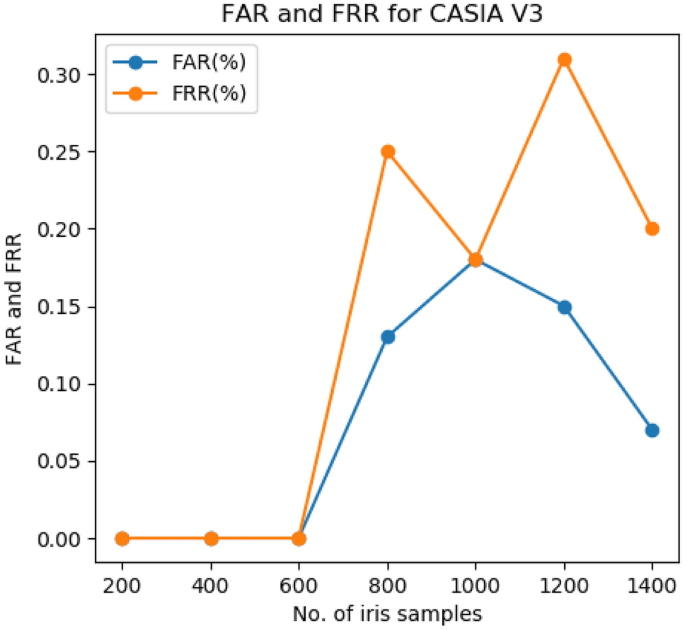
FAR and FRR of CASIA V3 iris dataset.
Similarly, the FAR and FRR of the FVC2006 fingerprint dataset are 0.14% and 0.20%, respectively (Fig. 3). The indicate where the FAR equals FRR is known every bit EER. Systems with a lower EER rate have college reliability and security The FAR and FRR of the iris dataset shows the commencement line of equals at 0.xviii which is lower compared to that of existing approaches.
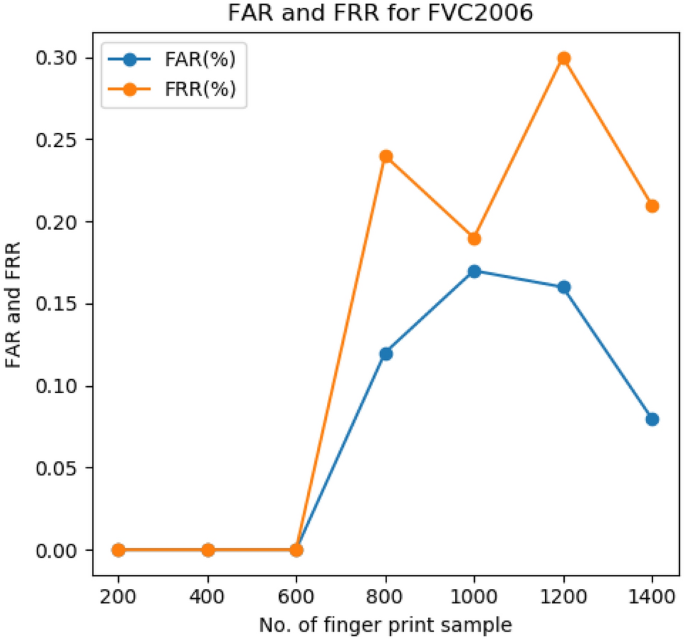
FAR and FRR of FVC2006 fingerprint dataset.
The comparing of the proposed approach confronting the TPR and TNR of the fingerprint dataset and iris dataset is shown in Figs. 4 and 5 respectively.
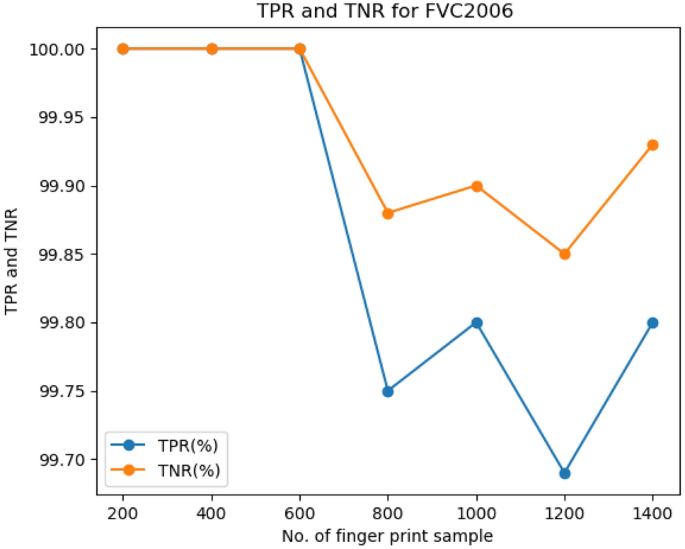
TPR and TNR of FVC2006 fingerprint dataset.
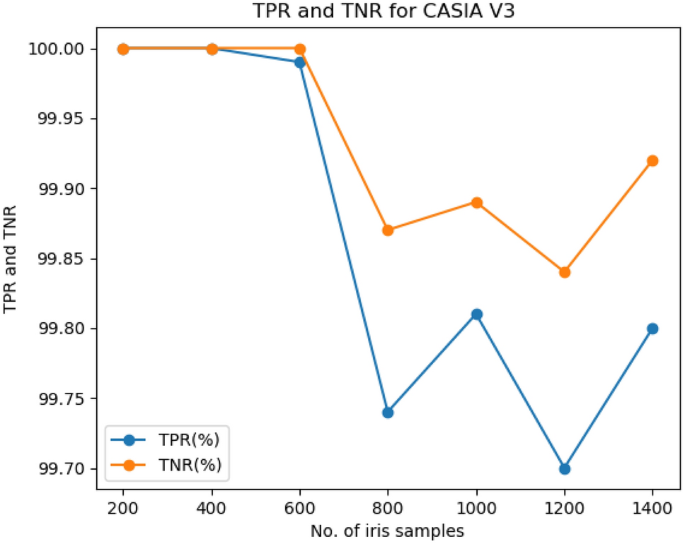
TPR and TNR of CASIA V3 iris dataset.
Comparative analysis
The six methods considered for comparison are Gavisiddappa et al.11, where the author uses fingerprints and irises with a modified relief approach that achieves an accuracy of approximately 97.09%. The 2nd method for comparing is the Jagadiswary et al.12 approach of the fusion level multimodal combination approach, which achieves a college accuracy of 87.6%. Vidya & Chandrause13 ELBP method feature extraction accomplished higher accuracy in multimodal biometrics of 91.0%. The adjacent method of comparing is Yang et al.xiv characteristic-level matching, given a college accurateness of xc%. Similarly, Malarvizhi et al.10 proposed a multimodal strategy based on soft computing approaches called an adaptive fuzzy genetic algorithm. The accuracy of their arroyo is 96%. Selwal et al.21 proposed a biometric recognition model based on a wedlock operation fuzzy relation strategy. The comparison of the proposed approach with various state-of-the-art existing approaches in terms of accuracy and EER are shown in Tabular array 4. The proposed approach is compared for FAR, FRR, Accuracy, and EER with the existing approaches.
The multimodal biometric system with higher accuracy seems to be more applicative for existent-time applications such every bit cyberbanking, passport, financial, login applications, etc. Feature choice is an of import aspect of the multimodal biometric security method in this study. Each biometric paradigm contains a big number of features and a big amount of information, resulting in the "curse of dimensionality" issue. Every bit a result, feature selection is disquisitional to optimize the features that are most suitable for classification. The accurateness of the system obtained based on their model is 97.iii%. The boilerplate accuracy of the proposed OFGA based multimodal biometric arrangement is 99.88%.
The accurateness comparison is depicted in Fig. 6 (A =ref 11 ; B =ref 12 ; C =ref thirteen ; D =ref 14 ; E =ref 10 ; F =ref 21 ; G =Proposed OFGA method). Similarly, the proposed approach is compared for EER with the state-of-the-art approaches. The boilerplate EER of the proposed method is 0.18%. The ERR comparison is depicted in Fig. 7.
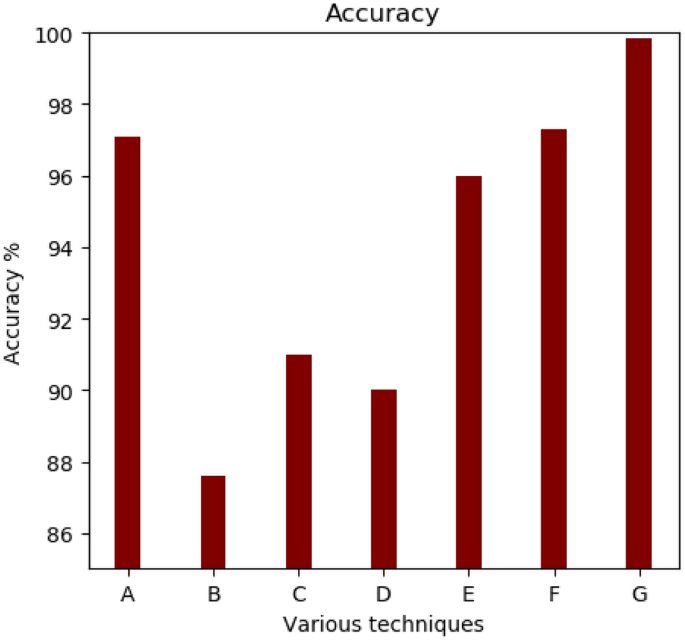
Comparative assay-Accurateness comparing.
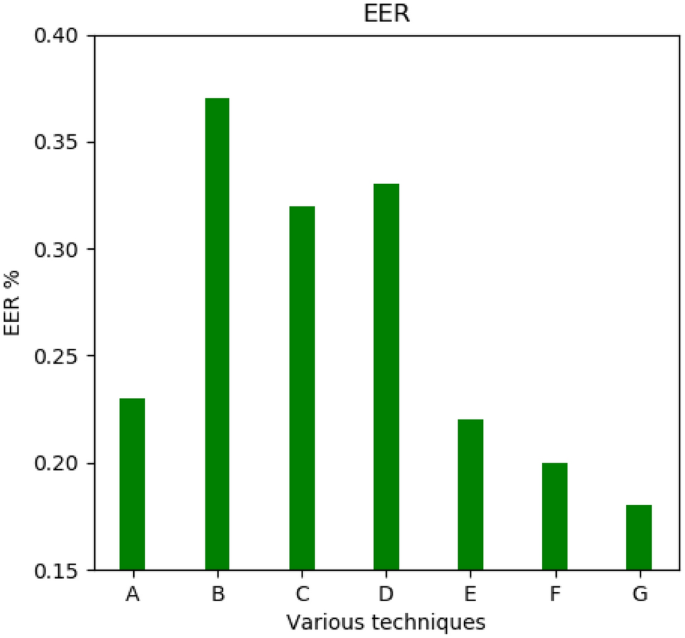
Comparative analysis-EER comparison.
Conclusion
The proposed approach for smart cities uses novel multimodal biometrics that uses fingerprint and iris biometric traits. The prime number objective of this method is to comprise enhanced fusion techniques with fuzzy models and soft computing approaches. Multimodal biometrics uses an optimized fuzzy genetic algorithm for an constructive fusion strategy and accurate biometric recognition. Initially, preprocessing is performed for both fingerprint and iris modalities.
The effective features extracted from the characteristic extraction mechanism are given as input in the score-level fusion pace. The optimized fuzzy genetic algorithm provides enhanced functioning in terms of higher accuracy, higher truthful positive rate, college truthful negative rate, lower simulated acceptance charge per unit, lower faux rejection rate, and lower equal error rate. The accuracy of the proposed approach is compared with 4 state-of-fine art existing approaches.
The comparison showed that the proposed arroyo provides an enhanced accuracy of approximately 99.89% and a lower equal fault rate of approximately 0.18%. The matching score obtained for fingerprint and iris biometrics in a large number of subjects indicates that this integration has real potential.
This method is advantageous for improving security because it improves overall efficiency and biometrics' underlying aliveness value in smart cities. In the time to come, more biometric modalities will be included in addition to fingerprints and irises to improve smart environments. Additionally, an enhanced classification algorithm will be used to boost accuracy.
Data availability
As human being information is used in the study, although it is a publically available dataset, all methods were carried out in accordance with relevant guidelines and regulations. All the fingerprints used in this work are taken from the dataset which is publically bachelor.
Source of dataset CASIA IRIS V3: http://biometrics.idealtest.org/findTotalDbByMode.do?mode=Iris#/datasetDetail/3.
Source of dataset FVC2006 DATASET: http://bias.csr.unibo.it/fvc2006/download.asp.
References
-
Rajasekar, V., Premalatha, J., Sathya, Grand. & Saračević, M. Secure remote user hallmark scheme on health care, IoT and cloud applications: a multilayer systematic survey. Acta Polytechnica Hungarica 18(3), 87–106 (2021).
-
Wencheng, Y., Wang, S., Hu, J., Zheng, G. & Valli, C. Security and accuracy of fingerprint-based biometrics: a review. Symmetry 11(ii), 141 (2019).
-
Gavrilova, M. 50., Ahmed, F., Azam, S., Paul, P. P., Rahman, W., Sultana, M., & Zohra F.T. Emerging trends in security system design using the concept of social behavioral biometrics. In Information Fusion for Cyber-Security Analytics 229–251 (Springer, 2017).
-
Donghoon, C., Garg, South., Hasan, M. & Mishra, S. Cancelable multibiometric arroyo using fuzzy extractor and novel bitwise encryption. IEEE Trans. Inf. Forensics Secur. 15, 3152–3167 (2020).
-
Rajasekar, Five., Premalatha, J. & Sathya, Thou. Multi cistron signcryption scheme for secure authentication using hyper elliptic bend cryptography and biohash role. Bull. Polish Acad. Sci. Tech. Sci. 68(iv), 923–935 (2020).
-
Galterio, One thousand. G., Angelic, Southward. S. & Hayajneh, T. A review of facial biometrics security for smart devices. Computers 7(3), 37 (2018).
-
Menon, V., Jayaraman, B. & Govindaraju, 5. Enhancing biometric recognition with spatiotemporal reasoning in smart environments. Pers. Ubiquit. Comput. 17(five), 987–998 (2013).
-
Ryo, O., & Yasushi, Y. Smart Device-based Multimodal Biometric Authentication with the Function for Environment Recognition. In Proceedings of international symposium on computing and networking (CANDAR), IEEE Volume Series: International Symposium on Computing and Networking 495–498 (2015).
-
De Marsico, M., Mecca, A. & Barra, Due south. Walking in a smart city: investigating the gait stabilization outcome for biometric recognition via wearable sensors. Comput. Electr. Eng. 80, 106501 (2019).
-
Malarvizhi, North., Selvarani, P. & Raj, P. Adaptive fuzzy genetic algorithm for multi biometric hallmark. Multimed. Tools Appl. 79(13), 9131–9144 (2020).
-
Gavisiddappa, One thousand., Mahadevappa, Due south. & Mohan, P. C. Multimodal biometric authentication organization using modified ReliefF feature selection and multi support vector machine. Int. J. Intell. Eng. Syst. 13(1), i–12. https://doi.org/10.22266/ijies2020.0229.01 (2020).
-
Jagadiswary, D. & Saraswady, D. Biometric authentication using fused multimodal biometric. Procedia Comput. Sci. 85, 109–116 (2016).
-
Vidya, S. B. & Chandra, E. Entropy based Local Binary Blueprint (ELBP) characteristic extraction technique of multimodal biometrics as defence machinery for cloud storage. Alex. Eng. J. 58(1), 103–114 (2019).
-
Yang, W., Wang, S., Zheng, One thousand. & Valli, C. Impact of feature proportion on matching functioning of multibiometric systems. ICT Express 5(ane), 37–40 (2019).
-
Rajasekar, Five., Premalatha, J. & Sathya, K. Cancelable Iris template for secure hallmark based on random projection and double random stage encoding. Peer-to-Peer Netw. Appl. 14(2), 747–762 (2021).
-
Al-Hmouz, R., Pedrycz, Due west., Daqrouq, K. & Morfeq, A. Development of multimodal biometric systems with iii-way and fuzzy set-based conclusion mechanisms. Int. J. Fuzzy Syst. 20(1), 128–140 (2018).
-
Manvjeet, K., & Sofat, S. Fuzzy vault template protection for multimodal biometric organisation. In 2017 International Briefing on Computing, Advice and Automation (ICCCA IEEE), Greater Noida, India 1131–1135 (2017).
-
EmadMajeed, H., Abbood, N. & Alani, A. A. Fuzzy logic decision fusion in a fingerprints based multimodal biometric organization. J. Eng. Appl. Sci. 14(three), 920–926 (2019).
-
Taranpreet, K., & Kaur, M. Cryptographic key generation from multimodal template using fuzzy extractor. In 2017 Tenth International Conference on Contemporary Computing (IC3 IEEE), Greater Noida, India, Aug 10–12 (2017).
-
Sujitha, V. & Chitra, D. A novel technique for multi biometric cryptosystem using fuzzy vault. J. Med. Syst. 43(v), 112 (2019).
-
Selwal, A., Gupta, Due south. K. & Kumar, South. A scheme for template security at feature fusion level in multimodal biometric organization. Adv. Sci. Technol. Res. J. 10(31), 23–thirty (2016).
-
Tong, Z., Ye, F., Yan, Thousand., Liu, H. & Basodi, South. A survey on algorithms for intelligent computing and smart city applications. Large Data Min. Anal. four(3), 155–172. https://doi.org/10.26599/BDMA.2020.9020029 (2021).
-
Huang, H. et al. Automobile learning-based multi-modal information perception for soft robotic easily. Tsinghua Sci. Technol. 25(2), 255–269. https://doi.org/ten.26599/TST.2019.9010009 (2020).
-
Pang, J., Huang, Y., Xie, Z., Li, J. & Cai, Z. Collaborative city digital twin for the COVID-xix pandemic: a federated learning solution. Tsinghua Sci. Technol. 26(five), 759–771. https://doi.org/x.26599/TST.2021.9010026 (2021).
-
Mabrouki, J., Azrour, M., Fattah, Yard., Dhiba, D. & Hajjaji, S. E. Intelligent monitoring organization for biogas detection based on the Internet of Things: Mohammedia, Morocco city landfill case. Big Data Min. Anal. 4(1), 10–17 (2021).
-
Rajasekar, Five., Premalatha, J., & Sathya, K. Enhanced biometric recognition for secure authentication using Iris preprocessing and hyperelliptic curve cryptography. Wirel. Commun. Mobile Comput. Art. No. 8841021 (2020).
Funding
This research received no external funding.
Author information
Affiliations
Contributions
Conceptualization, V.R.; B.P. and M.S.; methodology, D.M.; D.S.; P.J.; software, M.S.; validation, V.R., B.P. and M.East.; formal analysis, D.Southward. and M.Due east.; investigation, P.J.; writing—original draft training, V.R.; B.P. and M.Due south.; writing—review and editing, D.K.; D.S.; P.J; supervision, 1000.S.
Corresponding writer
Ethics declarations
Competing interests
The authors declare no competing interests.
Additional information
Publisher'southward note
Springer Nature remains neutral with regard to jurisdictional claims in published maps and institutional affiliations.
Rights and permissions
Open Access This article is licensed under a Creative Commons Attribution 4.0 International License, which permits use, sharing, adaptation, distribution and reproduction in any medium or format, as long as y'all give advisable credit to the original author(southward) and the source, provide a link to the Creative Commons licence, and indicate if changes were made. The images or other third party material in this article are included in the commodity'due south Artistic Commons licence, unless indicated otherwise in a credit line to the material. If textile is not included in the article's Creative Eatables licence and your intended utilise is not permitted by statutory regulation or exceeds the permitted use, yous will need to obtain permission directly from the copyright holder. To view a copy of this licence, visit http://creativecommons.org/licenses/by/4.0/.
Reprints and Permissions
About this article
Cite this article
Rajasekar, V., Predić, B., Saracevic, 1000. et al. Enhanced multimodal biometric recognition approach for smart cities based on an optimized fuzzy genetic algorithm. Sci Rep 12, 622 (2022). https://doi.org/10.1038/s41598-021-04652-3
-
Received:
-
Accepted:
-
Published:
-
DOI : https://doi.org/x.1038/s41598-021-04652-3
Comments
By submitting a annotate you agree to abide past our Terms and Customs Guidelines. If y'all find something calumniating or that does not comply with our terms or guidelines please flag information technology as inappropriate.
Source: https://www.nature.com/articles/s41598-021-04652-3
0 Response to "Multiple Classifiers in Biometrics Part 1 Fundamentals and Review"
Publicar un comentario